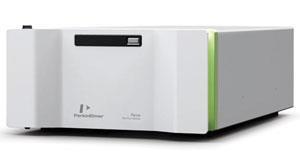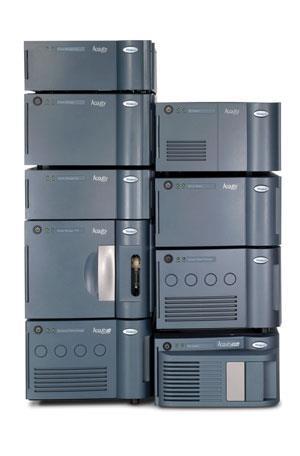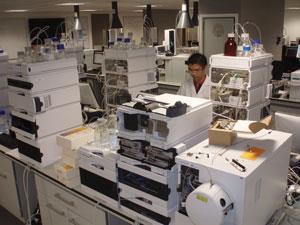
When entering into plasma, most compounds bind rapidly to blood components. Pharmaceutical companies need to consider the plasma protein binding properties of a chemical to see how effective it is and how widely it is distributed into body tissues. High performance liquid chromatography (HPLC) has become one of the major techniques used in the industry to carry out this type of work.
First used in the mid-20th century, LC has matured and is now the workhorse of industrial analysis, while the pharmaceutical sector is one of the main customers of HPLC manufacturers. Chromatography is a technique that separates components in a mixture. The differing time taken for each component to travel through a stationary phase when carried through it by a mobile phase (gas or liquid) reveals the presence of the component. This is known as the retention time.
In LC processes, a solvent slowly filters down through the solid stationary phase, bringing the separated components with it. When HPLC is used, however, the sample is forced by a liquid at high pressure through a column packed with a stationary phase. This is made up of small irregular particles, a porous monolithic layer or a porous membrane. The small particle size for the column-packing material provides a greater surface area for interactions between the stationary phase and the molecules flowing past it. This improves the separation of the mixture components. For example, in pharmaceutical laboratories, a column containing human serum albumin could be used to screen the plasma protein binding of particular compounds.
Material improvements
The HPLC instrument consists of a number of parts, such as a mobile phase reservoir, degasser, pump, injector, column, detector and data processor. Much of the improvement in HPLC technology over the last decade is due to column refinements, as Mark Ward of LC column manufacturer and distributor Hichrom explains. ‘Developments in LC column technology over the last few years have helped push the boundaries of HPLC in a number of exciting areas, including improved efficiency, better column stability and a wider choice of robust LC column selectivities.’
Smaller particle sizes (2µm or below) have enabled greater separation efficiencies (see Stationary phases move ahead). However, chemists have had to deal with a trade-off between particle size reduction and increased pressures. But Ward says solutions are becoming available. ‘In recent years, solid core, superficially porous particles (SPPs) have also enabled higher separation efficiencies, but without the higher pressures inherent with smaller particles.’
Silica hybrid materials were introduced a few years ago with good pH stability
Meanwhile, HPLC column pH stability has also improved. Traditional LC base materials include zirconia, alumina, titania and polymers. According to Ward, these provide good pH stability at the cost of lower separation efficiency. The pH stability affects the reliability of the process, which in turn influences how many samples are run and how often.
New materials have also helped. ‘Silica hybrid materials were introduced a few years ago with the aim of producing LC columns which still had good pH stability but which also had improved separation efficiency,’ he says. At the same time, better LC phase bonding technology has provided chromatographers with alternative selectivity with similar strength and reproducibility as on previous models.
Wilhad Reuter, application technologies and LC specialist at manufacturer PerkinElmer, confirms the emphasis on column improvements. ‘We are constantly looking at higher pressures, but the columns have to keep up with that. At the moment we cannot get higher than 13,000psi – but we’re working on it,’ he says.
Shimadzu, one of the main producers of HPLCs along with Waters, Agilent and ThermoFisher, does not focus heavily on column technology, according to Stuart Phillips, business manager for LC and LC·MS. Instead, it works with column vendors to make a system that works well with all of them. ‘The Nexera UHPLC works really well with everything from HPLC to UHPPC – it’s designed to be completely flexible,’ he says. ‘Our system is rated to 1300bar [~19,000psi], which is currently the highest on the market.’
Rise of the ultras
Ultra high pressure LC (UHPLC) has driven HPLC into the fast lane, and is the most recent generation of HPLC products. Waters executives suggest the company’s own research developed it in the first place. ‘The Acquity UPLC technology, introduced 10 years ago, launched a new category of separations system. UPLC, or UHPLC as others refer to it, is a major advancement in technology because it brings dramatic improvements in speed, resolution and sensitivity over conventional HPLC,’ says William Foley, senior director of separations product marketing at Waters. Acquity is one of the company’s product ranges.

As Foley indicates, the company launched a rethink of HPLC at that time. ‘The design process called for new thinking in many areas; new designs for solvent management, which when combined with new software algorithms are capable of a constant linear flow at elevated pressures; high-speed detectors with high-speed data capture rates and faster injection cycles to keep up with the instrument’s higher throughput.’ The researchers also aimed for more robust system and system components. This means withstanding higher operating pressures for long periods of time while optimising the flow path to cut internal system volume in order to reduce dispersion.
The result, he says, was a dramatic improvement in performance. ‘Acquity UPLC systems have numerous advantages over their HPLC brethren using 5²m column particles. They are nine times faster than today’s fastest HPLC systems at completing sample runs. They offer twice the peak capacity or resolution, three times better routine sensitivity, and, generally speaking, more information from a single run than anything today’s HPLC systems can provide,’ he adds. However, Waters also produces a series of HPLC products known as the Alliance range.
Reuter confirms the superior performance of UHPLC. ‘It enables small particle sizes below 2µm for exceptionally greater separation power. People choose it for that reason. You separate the components faster, cutting retention time from 25 to five minutes. UHPLC particularly lends itself to forensics, drug analysis, pesticides and biotechnology. It is better and faster, but is not likely to open up new fields of work,’ he says.
Most companies sell UHPLC products, though HPLC is still the standard. UHPLC instruments are more expensive than a standard HPLC system, which might cost £50,000 plus service contract. UHPLC also reduces solvent consumption and this can cut some of the cost to the customer. The overall cost of this technology, however, is usually higher than HPLC.
But Reuter suggests that another alternative, the SPP column, provides different advantages. SPP columns have emerged over the last three years and can be used with an existing HPLC instrument. ‘UHPLC is not the only game in town ` the advantage of SPP is that they have the same separation performance as UHPLC columns but because the samples do not migrate into particles of the column’s stationary phase, that provides for a lot lower back pressure in the system,’ he says.
According to Reuter, chemists get the same separation performance and retention time with 3000–6000psi on SPP columns as with UHPLC. Most manufactures now sell HPLC using SPP columns, which are becoming more resistant each year. It is an important consideration. ‘If the column is not robust enough, the peak shapes get shorter and deteriorate and retention times start drifting,’ he explains.
Detecting improvements
New types of detectors have also helped drive advances in research work. For example, PerkinElmer’s Flexar PDA Plus detector includes flexibility of modular design and provides greater sensitivity, accuracy and faster sampling speeds with its photo diode array (PDA). According to company literature, its assets include the widest dynamic linear detection range, the highest data acquisition rates, excellent wavelength accuracy and a very low baseline noise.
Detector sensitivity is a major competitive area in HPLC manufacturing. Another is, of course, column quality. However, there are also major efforts to reduce pump volume delays and increase power ranges. Injection precision, ease of use, robustness and cost are other considerations for buyers. UHPLC can save money in some cases.
Swiss chemicals producer Nitrochemie says it chose an Agilent 1290 Infinity LC system. Like other manufacturers, Agilent produces a wide range of different HPLC products. However, Nitrochemie laboratory manager Beat Vogelsanger says he was able to replace five of the laboratory’s older conventional HPLC systems with just one Agilent UHPLC product because of the savings in processing time. Together with the reduction in solvent usage, the total cost of ownership savings are estimated at CHF100,000 (£70,000) per year.
Beyond Waters’ original leadership in UHPLC, there is relatively little product differentiation in HPLC instrumentation, a now common feature of chemistry laboratories across the world. According to Stuart Warriner, a user of HPLC at the University of Leeds in the UK, none of the manufacturers are noticeably superior to the others. ‘Waters was the first to produce UHPLC, using smaller particle size columns. But we also have Thermo Fisher and Agilent, which can exceed Waters’ spec,’ he says.
We have the lowest carry-over autosampler on the market
Chemists using the technology are appreciative of the improved speeds in retention and processing times. The general expectation is for incremental improvements based on the same foundations, rather than massive leaps in innovation. Warriner partly attributes improved HPLC performance to better hardware, such as detector sensitivity, as well as column improvement. ‘What you’re interested in if doing peak runs is cycle times. Autosampler cycle times have reduced,’ he says.
According to Warriner, so-called hyphenated techniques have greatly improved chemists’ work, allowing them to connect LC to mass spectrometry (MS) and improving processing speeds. Producers confirm this trend. ‘In discovery and research applications, the increase in use of all types of MS has greatly influenced our R&D efforts with regard to separations products. The demand from customers to optimise resolution, increase ionisation efficiency and improve LC/MS sensitivity is driving innovation in the area of chromatographic separations,’ comments Foley of Waters.
Phillips suggests that the increase in sensitivity of MS has led to problems with ‘carry-over’: when small amounts of previous samples left behind in autosamplers are present in what you are currently testing. At the low levels the instruments are now capable of sensing, even the smallest amount of carry-over can cause problems. Shimadzu has worked very hard on this problem, he says, and with the SIL-30ACMP autosampler, ‘We’re quite confident that we have the lowest carry-over autosampler on the market.’
Another Shimadzu advance that Phillips is proud of allows users to detect peaks that remain unseparated even by UHPLC. The intelligent peak deconvolution analysis system (i-PDeA) produces the first derivative of the UV spectrum obtained by the photodiode array. This allows the main peaks to be ‘removed’ and reveal smaller impurity peaks that would otherwise be hidden.
Service and ease
While better technology is available than a few years ago, Warriner suggests service standards could improve. ‘You need a lot of after-sales service with HPLC due to moving parts. Seals need to be changed, things break and they need fixing. The annual service contract is normally 15·20% of the purchase price,’ he says. But he adds that companies do not always reach the service standards expected for the products, which stay up-to-date for about five years but may last a decade.
‘With all scientific instrumentation you are reliant on ongoing maintenance and there are third party service companies as well. When you select a producer, it’s not just about the hardware and software but about the support it provides over the product’s lifetime and the ability of manufacturers to provide the service support you need. My advice to an HPLC buyer is to think about the service strategy.’

Foley envisages a need for improved ease of use of LC as a major product development. Technicians in many laboratories are asked to work with a broader array of instrumentation and techniques. HPLC innovations in detectors, for example, could help provide the necessary bridge with other technologies. ‘This demand for easier-to-use technologies, that generate high-quality data consistently that scientists aren’t afraid to put their name to, is the driving focus for our newest detector for LC, the Acquity QDa Detector,’ says Foley.
Introduced in October 2013, he says this detector makes mass spectral information available to chromatographers so that they can get this information themselves rather than sending samples off to an MS laboratory for compound confirmation. ‘We believe that ease of use can be considered a very important innovation that will lead to the expansion of the use of LC as a technology,’ predicts Foley.
According to John Lough, reader in pharmaceutical analysis at the University of Sunderland in the UK, UHPLC is likely to be the way forward for LC research. ‘Waters introduced UPLC in 2004 but now equipment is beginning to lag behind the column technology again. Waters is still the most innovative of the LC instrument manufacturers,’ he says.
Pharmaceuticals, he says, will continue to be a core customer of HPLC producers, though other fields may be growing in countries where traditional pharmaceutical industries are declining. ‘In pharma, the big change is the growth in biopharmaceuticals. These present a quite different LC challenge. Thermo Fisher is doing a very good job in introducing new ion-exchange and affinity LC materials to meet that challenge,’ he says.
Elisabeth Jeffries is a science writer based in London, UK












No comments yet